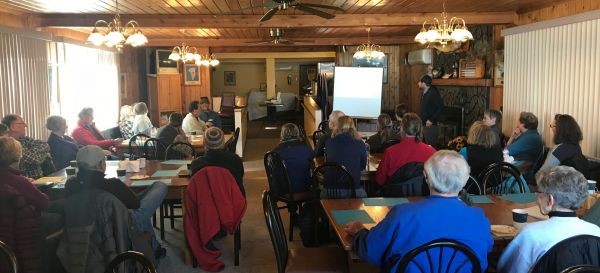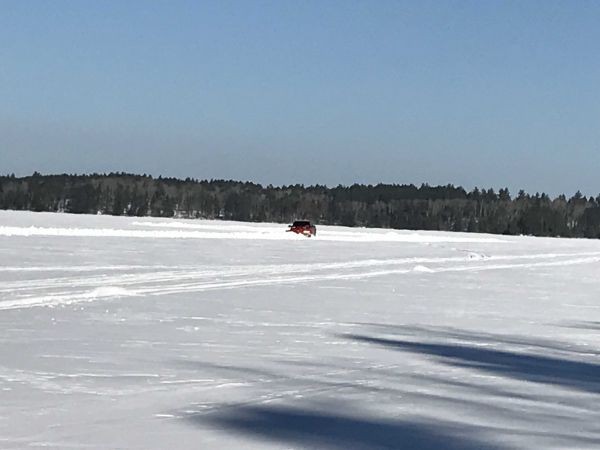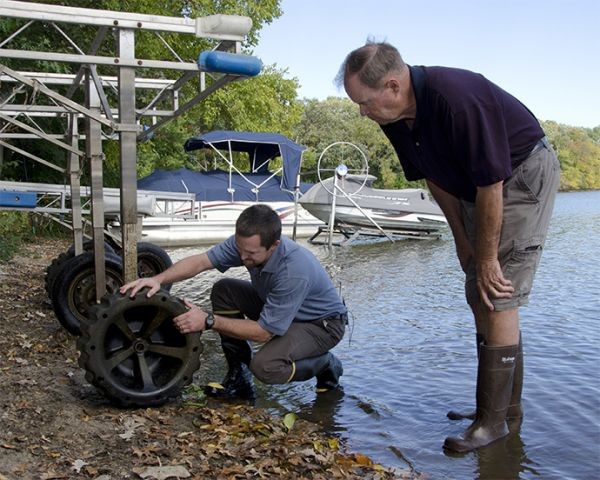Posted March 26, 2018 on The Quetico Superior Foundation website
Originally published by the St. Croix Watershed Research Station, the field station of the Science Museum of Minnesota.
A chemical called sulfate is causing a lot of conflict and confusion in Minnesota. This discharge from iron mines, wastewater treatment plants, and proposed copper mines is essentially harmless to humans, but causes a “biogeochemical cascade” when it increases in lakes and rivers.
One of those impacts is best-known and most-debated: harm to wild rice, or manoomin. The Research Station has been involved in recent studies seeking to explain the connections between sulfate, Minnesota’s state grain, and a multitude of other causes and effects.
Now, new peer-reviewed publications detail the wide-ranging ways sulfate changes lakes and streams.
“Put sulfate into our dilute northern Minnesota waters and you will get a different environment,” says Research Station director emeritus and senior scientist Dr. Dan Engstrom, who was central to the studies. “In many ways it’s a lot worse than putting road salt into a lake, because sulfate is much more reactive.”
While rising salt levels have raised concerns recently, and can have negative effects on water, sulfate sets off a serious chain reaction.
Canary in the copper mine?
It is an important time to understand the issue: A judge recently struck down a proposed new sulfate standard to protect wild rice, and the State is in the middle of a public comment period on permits for PolyMet, the first company seeking to operate a copper-nickel mine in Minnesota. The project has the potential for significant sulfate discharges into the St. Louis River headwaters.
Wild rice was described by the University of Minnesota researchers who the Research Station partnered with as a “canary in the coal mine” for stream health. If wild rice isn’t thriving, something is amiss.
Already, iron mining and other human land uses have eradicated wild rice from many lakes where it once grew.
The alarm sounded by vanishing manoomin can also alert us to other ways sulfate is at work. The chemical can lead to increases in nutrients, which might cause more algae and other plant growth in a waterbody. It can be converted to sulfide in bottom sediments, which is toxic to many aquatic plants in addition to wild rice. It can otherwise disrupt the water chemistry, changing almost everything about a lake. And it can create toxic mercury levels in fish that people like to catch and eat.
Making mercury more dangerous
“This isn’t just about wild rice,” lead author Dr. Amy Myrbo says. “We’ve now found that putting sulfate into our water has consequences down the line, including more mercury in fish, changes in habitat for ducks, and changes in the food chain.”
Sulfate most directly affects wildlife and human health by increasing the conversion of mercury to methylmercury, the most dangerous form of the toxic element. Mercury is linked to poor brain development in fetuses, as well as neurological problems like tremors, insomnia, memory loss, headaches, and cognitive and motor dysfunction.
Sulfate fuels a certain type of bacteria that live in low-oxygen bottom waters. Not only do these microbes “breathe” sulfate, but they also produce methylmercury as part of their unusual biology. This form of mercury easily works its way up the food chain, from plankton to game fish.
At every step, the concentration increases, until it reaches dangerous levels in top predators.
In one 10-year study in northern Minnesota, the researchers teased out complicated connections between sulfate, mercury, water, and weather. They measured how adding sulfate to a wetland caused a dramatic rise in methylmercury in the water, the peat, and aquatic insects.
Feeding fertility
Excess nutrients in water bodies is a problem more closely associated with southern Minnesota and other areas with intensive agriculture and other development in their watersheds. But sulfate can also make the relatively sterile lakes of northern Minnesota more fertile.
Most of these lakes have low levels of oxygen at the bottom. This means dead plants decompose slowly, storing carbon, phosphorus, nitrogen, and other nutrients.
But sulfate can speed up decomposition, releasing the nutrients more quickly, and fertilizing the water. That changes what plants thrive there, and increases the occurrence of nuisance or harmful algae blooms.
As the climate continues to warm in the decades ahead, especially in northern Minnesota, increased plant growth is already expected. Adding more sulfate could multiply the effects in the region’s beloved lakes.
Root problem
A lot of the life in a lake grows from the bottom. Plants with roots in the sediments are critical to aquatic ecosystems, gathering sun from above, dissolved carbon from the water, and nutrients from the muck below.
That mud happens to be the same place where sulfate turns into sulfide, converting a relatively harmless compound to a poison toxic to most forms of life.
Sulfide is sort of the anti-oxygen. Organisms such as people and fish and most life forms depend on oxygen for critical chemical reactions that keep us alive. But in places where there is not much oxygen, other organisms use sulfide for similar purposes. Sulfide-dependent organisms don’t like oxygen, and oxygen-dependent organisms don’t like sulfide.
If the amount of sulfide in bottom sediments gets too high, almost all native plants suffer. They don’t grow, and they don’t reproduce.
Native plants like wild rice and other rooted aquatic vegetation have special strategies to fend off sulfide. They take oxygen from the water and pump it out through their roots to interfere in the chemical reaction that produces sulfide. But that defense can only go so far.
As sulfate levels rise in the water and cause increasing sulfide in the sediments, it overwhelms the plants. They are eventually replaced by a limited number of species that can tolerate sulfide-rich conditions.
Degrading biodiversity
Engstrom says he has seen for himself what a wetland with a lot of sulfate looks like. In studies on the Iron Range, he studied marshes where mining companies discharged wastewater.
The wetlands were a monoculture of cattails. In other related studies, scientists grew cultivated (white) rice in tanks and experimented with adding sulfate and other chemicals. When the ingredients were present to convert the sulfate to sulfide, the rice failed to thrive. The chemical is simply is not compatible with most aquatic vegetation.
Engstrom points to the implications of mineral exploration occurring upstream of the Boundary Waters Canoe Area Wilderness, with its fragile and unique ecosystem.
“We don’t know all the aquatic plants that are sensitive, but if you look at the diversity of lakes in the Boundary Waters, it’s a beautiful assemblage, including underwater,” he says. “Sulfate could knock a lot of those plants out.”
To view the original article with references go to;
http://queticosuperior.org/blog/mercury-manoomin-sulfate-causes-ecological-ripples-minnesota-waters#.WsJ9uExFzIU









